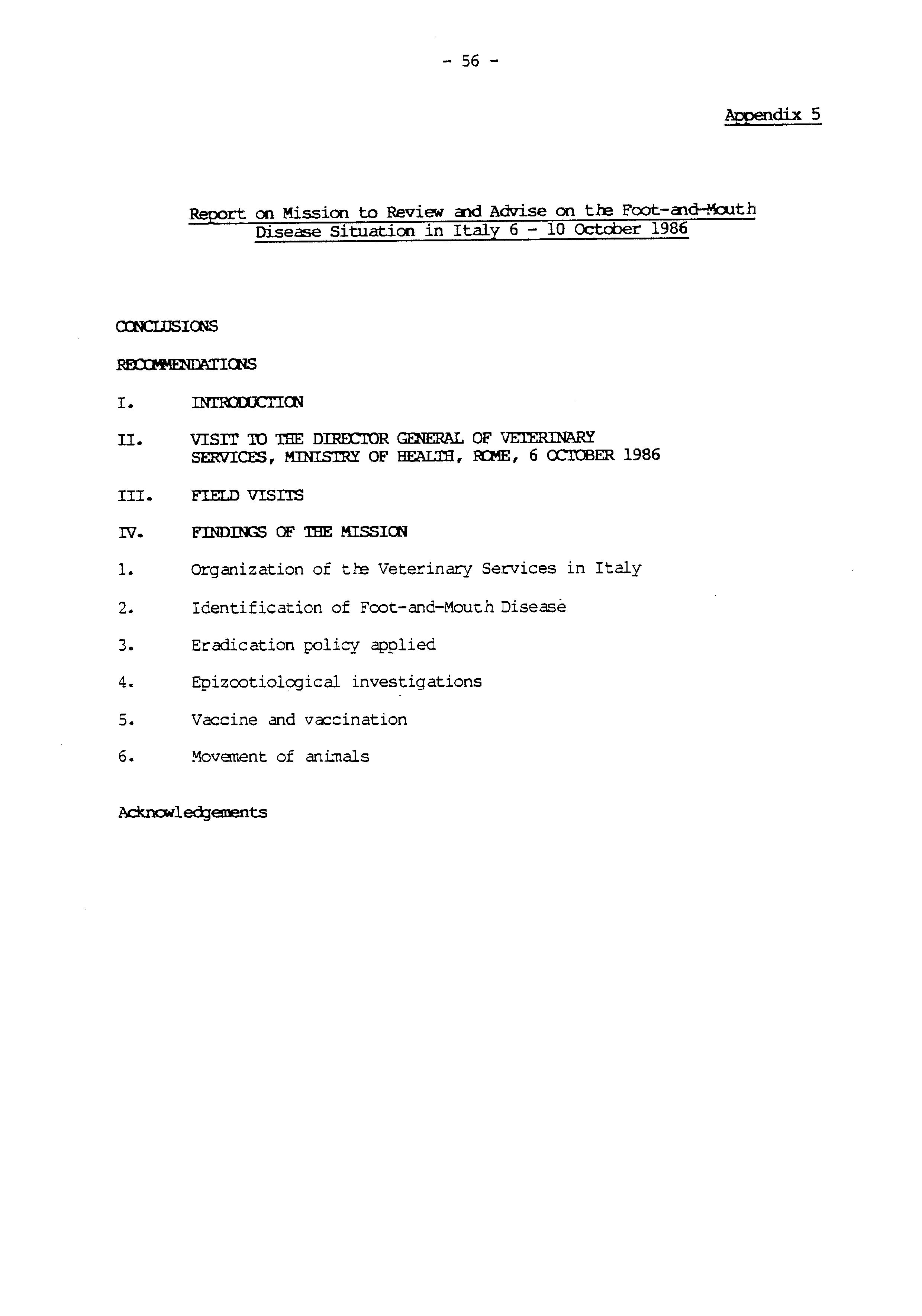
28 minute read
advise on the FMD situation in Italy, 0::tober 1986
Appendix 5
Report on Mission to Review clld Advise on tl:e Foot-a1d--Ma.lth Disease Situation in Italy 6 - 10 Octooer 1986
Advertisement
CCNCLUSICNS
~CNS
I. nmon:'IT{ll1
II. VISIT 'ID TEE DIRE.rl'OR GENERAL OF VETERINARY
SERVICES, MINISmY OF HFALTH, :ECME, 6 OCTOOER 1986
III. FIELD VISITS
N. FINDilG5 OF 'IEE MISSICN
2. Identification of Foot-and-Mouth Disease
3. Eradication policy applied
4. Epizootiolcgical investigations
5. Vaccine and vaccination
6. !1ovement of animals
Ackncwled_;Jements
a:::N:r..USIOIS
The Mission, having reviewed and examined all data obtained concluded that among t:.e main reasons for the persistence of the FMD epizootics in Italy since November 1984, the following are of note:
1) Relaxation of vigilance and proplylaxis cgainst foot-and-mouth disease because of the favourable disease situation in tte period prior to tre present epizootic.
2) High percentcge of susceptible an1..1als inadequately protected against foot-and-mouth disease despite official confirmation that the total cattle population (9 million J-:ead) had been vaccinated during the canpulsory annual vaccination (Novernber-J anuary) 1984-85.
3) Vaccination not applied according to standard met.h:xls. Automatic guns/vaccination in different parts of the body used instead of tre tradi:.ional metlDd of vaccination previously in use which guaranteed proplylactic vaccination cgainst c'MD in a high percentcge of the cattle population.
4) Possiblity of incorrect shelf conservation of vaccine by the vaccinators w hie h could have canprcmised its efficacy.
5) Delays in tre implementation of t.!-:e annual vaccination canpaigns attributed to t.!-:e non-availability of t.!-:e vaccine on time in t.J-:e field and to the uncontrolled use of the vaccine during the canpaigns.
6) Stamping out policies, disinfection and sanitary measures not effectively applied to the infected and restricted areas.
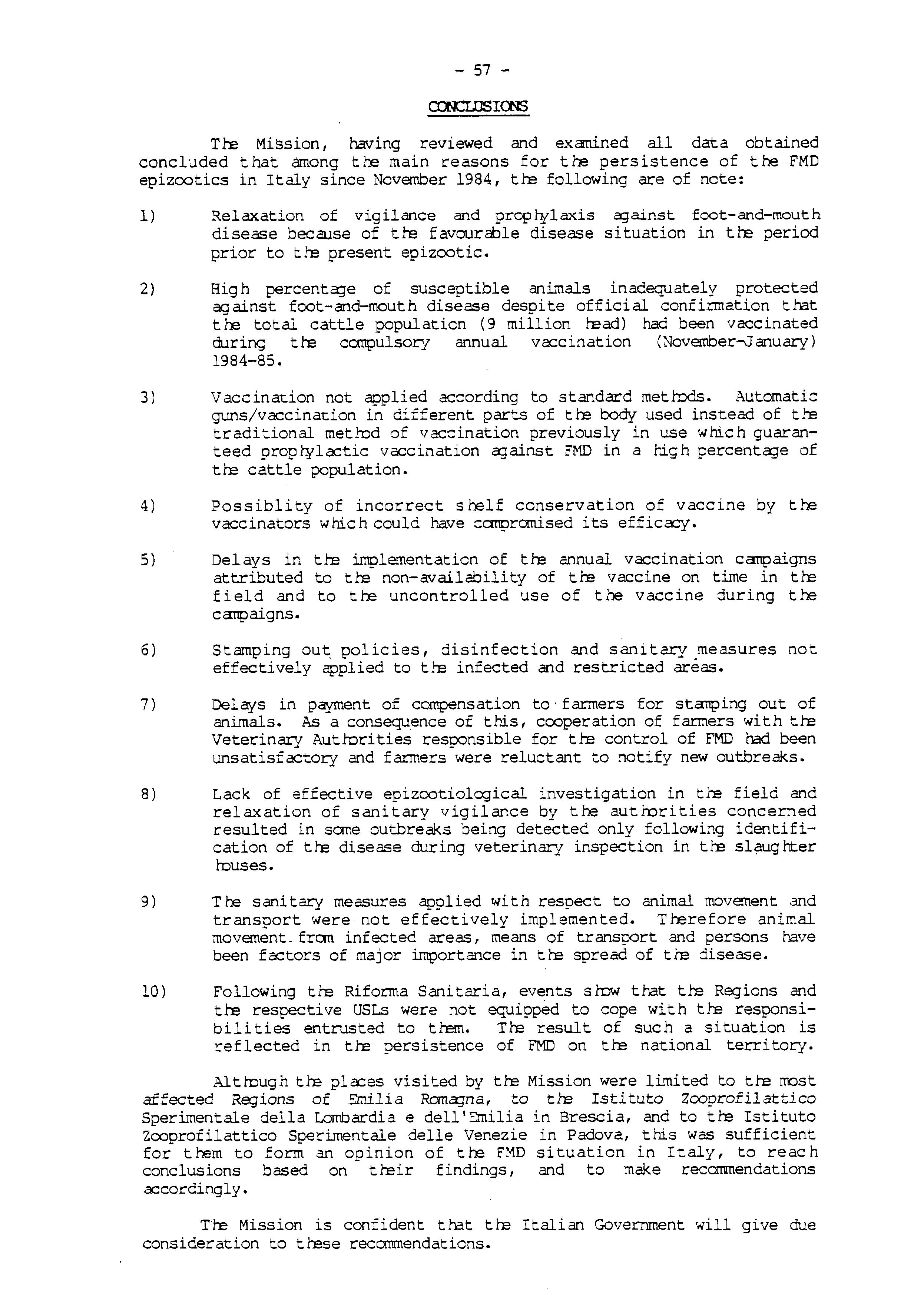
7) Delays in payment of compensation to· farmers for stanping out of animals. As a consequence of t.bis, cooperation of farmers with t.!-:e Veterinary AutlDrities responsible for t.!-:e control of FMD had been unsatisfactory and farmers were reluctant t:o notify new outbreaks.
8) Lack of effective epizcotiological investigation in tre field and relaxation of sanitary vigilance by the aut.rorities concerned resulted in sane outbreaks ':)eing detected only following identification of t.!-:e disease during veterinarJ inspection in t.!-:e sl?ug ht.er rouses.
9) T re sanitary measures applied with respect to animal movement and transport were not ef fee ti vely implemented. T J-:erefore animal movement_ fran infected areas, means of transport and persons have been factors of major importance in tre spread of tre disease.
10) Following tre Riforrna Sanitaria, events srnw that t.!-:e Regions and tre respective USLs were not equipped to cope with t.J-:e responsibilities entr-isted to t.!-:em. T.!-:e result of such a situation is reflected in t.!-:e persistence of FMD on t.J-:e national territory.
Altrough the pla:es visited by t.!-:e Mission were lLrnited to the rrost affected Regions of Emilia Rana:;rna, to the Istituto Zcoprofilattico Sperimentale della Lcmbardia e dell'Smilia in Brescia, and to t.!-:e Istituto Zooprofilattico Si;:€rimentale delle Venezie in Padova, this was sufficient for tr.em to form an opinion of tre FMD situation in Italy, to reach conclusions based on t.!-:eir findings, and to :n.ake recanmendations accordingly.
~CN:i
1. Orga1iz'aticn of tre Veterinary Services in Italy
It is essential that tra animal tealth control policy be coordinated between tte USLs within a Region, and between tte Regions.
A Central Unit srnuld be set up to supervise activities at USL/Regional level.
In case of an emergency at national level, coordination of action srould be tte responsibility of one Central National Veterinary Autrority.
2. Identification of Foot-and-Mouth Disease
3.
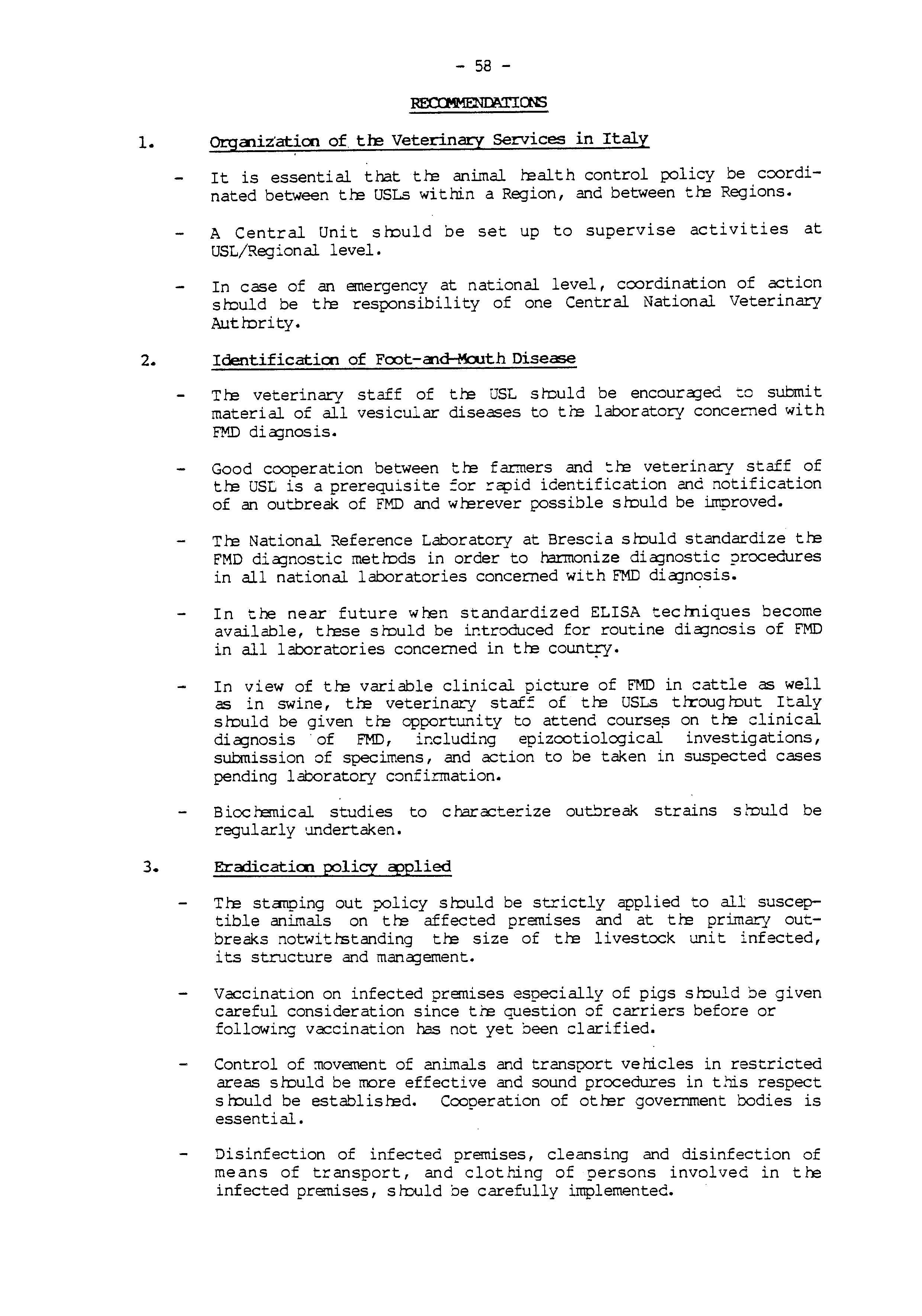
Tte veterinary staff of tte OSL srould be encoura;)'ed to submit material of all vesicular diseases to tte laboratory concerned with FMD di a;)'nOS is.
Good cooperation between tre farmers and :.te veterinary staff of tte USL is a prerequisite :or rapid identification and notification of an outbreak of FMD and w terever i;::ossible s rould be improved.
Tra National Reference Laboratory at Brescia srould standardize tre FMD dia;)'nostic metrods in order to rarmonize dia;)"nostic procedures in all national laboratories concerned with FMD dia;)"nosis.
In the near future wren standardized ELISA teclniques become available, trese srould be introduced for routine dia;)"nosis of FMD in all laboratories concerned in tte cou.nqy.
In view of tte variable clinical picture of FMD in cattle as well as in swine, tte veterinar<J staf:: of tte USLs tlrougrout Italy srould be given tte opportunity to attend coursep on tte clinical dia;)"nosis · of FMD, including epizcotiolcgical investigations, submission of specimens, and action to be taken in suspected cases pending laboratory confirmation.
Biochemical studies to ch:lracterize outbreak strains smuld be regularly undertaken.
Erad.icaticn :e?licy '!?Plied
T te stanping out policy s rould be strictly applied to all susceptible animals on tre affected premises and at tre primary outbreaks notwittstanding tre size of tte livestock unit infected, its structure and mana;)'ement.
Vaccination on infected premises especially of pigs srould be given careful consideration since tte ouestion of carriers before or following vaccination has not yet been clarified.
Control of '1lovement of animals and transport vehicles in restricted areas smuld be more effective and sound procedures in this respect s rnuld be establisred. Cooperation of otter government bodies is essential.
Disinfection of infected premises, cleansing and disinfection of means of transport, and clot.bing of persons involved in the infected premises, srould be carefully implemented.
4.
T re definition of infected and restricted areas s hJuld be clearly indicated and tre quarantine measures applied to trese areas srould be strictly observed,
Epizcotiolcgical investigations
Serum sanples and probang sanples s h::iuld be collected fran as many animals on an infected. premise as is practicable and from a sample of aninals on :arms surrounding an infected pre.,nise. Trese animals srould be clinically exanined and tre cge of F~ lesions estimated.
Questionnaires sJ-ould be available to all veterinary staff investigating FMD outbreaks. T rese questionnaires s rould be standard for all regions and be prepared by an epiderniolcgist experienced in tre investigation of FMD outbreaks.
Possible contacts with tre infected premises must be tJ-oroug hly investigated. I.: this involves premises in different regions tre investigations sJ-ould be coordinated by national autJ-ority.
A Task Force shJuld be set up at national level to cope with emergency animal disease situations especially frll.D.
Standard procedures :or epizcotiolcgical investigations s J-ould be set up.
Seminars on simulation exercises on emergency :MD outbreaks s J-ould be organized at !:'egional levels in order to creek tre preparedness of tre Veterinary Services to face emergency FMD si~uations.
5. Vaccine a:id vaccination
Az iridin compounds s rould be used to replace formalin as an inactivant for F~D vaccine. This procedure would allow for innocuity testing of tre inactivated virus prior to adsorption.
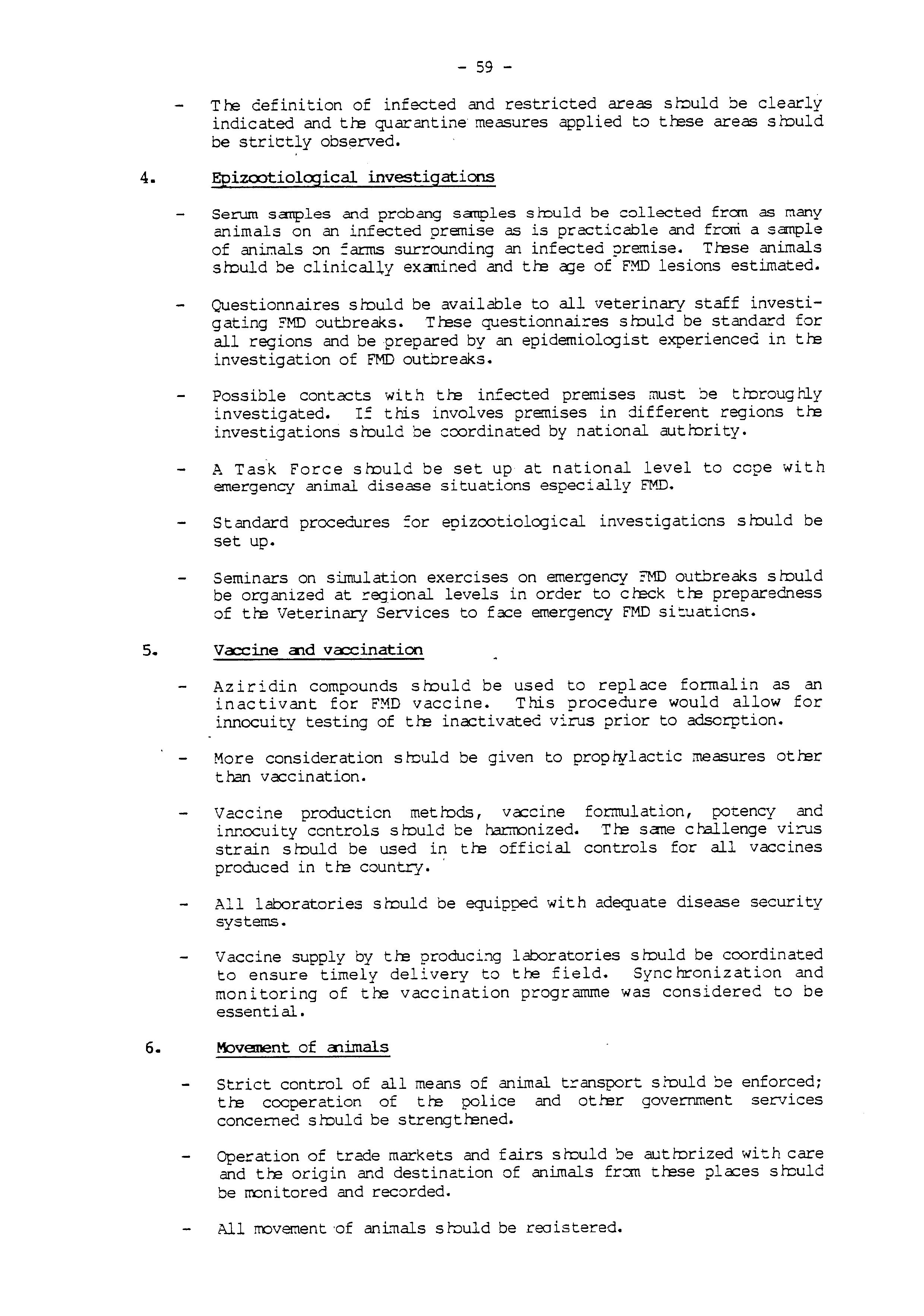
More consideration s l"Duld be given to proplylactic measures otrer than vaccination.
Vaccine production metJ-ods, vaccine formulation, potency and inr.ocui ty controls s rould be harrronized. T re sane c r.allenge vir..is strain sJ-ould be used in tre official controls for all vaccines produced in tre country. ,
All laboratories sJ-ould be equipped with adequate disease security systems.
Vaccine supply by tre produci~g laboratories srnuld be coordinated to ensure timely delivery to tre field. Synchronization and monitoring of tre vaccination programme was considered to be essential.
6. Movenent of a:iimals
Strict control of all means of animal transport smuld be enforced; tre cooperation of tre police and otrer government services concerned srnuld be strengtrened.
Operation of trade markets and fairs srnuld be autJ-orized with care and tre origin and destination of animals fr::m trese places sh:::uld be rronito~ed and recorded.
I. INI'ROOOCI'ICN
On 13 September 1986, tre Director-General of Veterinary Services in Italy, addressed a telex to tre European Corrmission for tre Control of Foot-and-Mouth Disea':ie ( EUFMD) requesting that a group of experts from member countries of tre Canmission visit Italy to exanine tre FMD situation which had persisted on tre national territory since November 1984.
This request was discussed at an ad .Inc meeting of tre Executive Committee of the EUFMD held on 17 September 1986 during the 12th 0IE Regional Conference for Europe which wa-3 reld in Berlin, GDR, £rem 16 to 19 September. At this meeting tre Executive Cornnittee decided that a Mission srould visit Italy £rem 6 to 10 October 1986 to investigate tre FMD situation and make appropriate reccrrmendations to tre Government.
Tre Secretary of tre EUFMD was instructed to make tre necessary arrangements for tre implementation of tre Mission and subsequently to arrange for tre Executive Committee to present the findings of the Ccmmission to tre Government at an ad .Inc meeting to be convened at tre Ministry of Health in Rome as soon as ~ssible following tre Mission.
Tre Mission was composed of:
Dr. F. Walla, Director of Veterinary Services, Austria Dr. P. Gafner, Director of Veterinary Services, Switzerland Dr. J. Westergaard, Head of Division, State Veterinary Service, Denmark Prof. R. Ahl, Federal Research Institute for Animal Virus Diseases, Ti.lbingen, FRG Dr. R. P. Kitching, Animal Virus Research Institute, Pirbrig ht, UK Dr. P. Stouraitis, Secretary, EUFMD, FAO, Rane
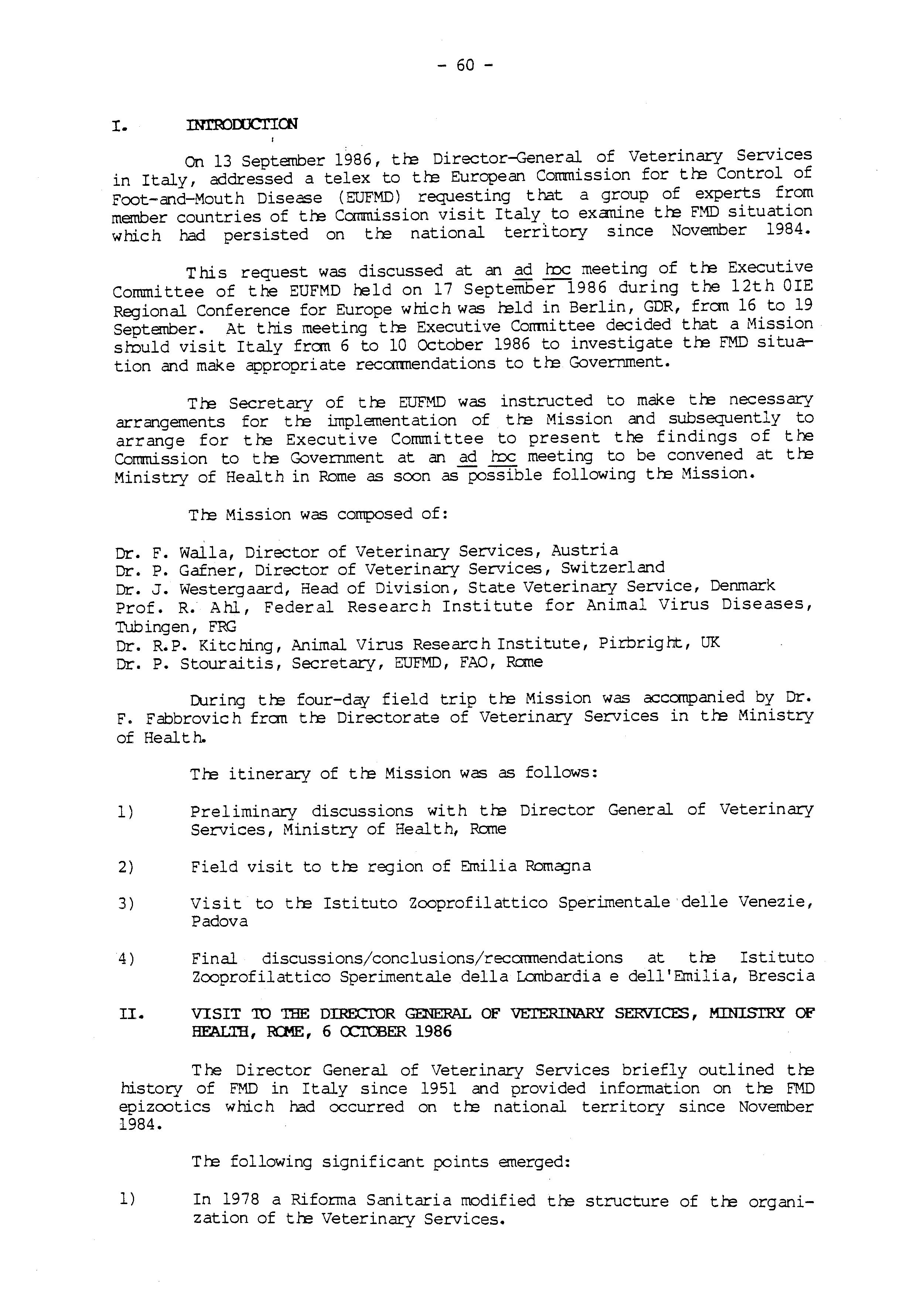
During tre four-day field trip tre Mission was acccmpanied by Dr. F. F abbrovic h £rem tre Director ate of Veterinary Services in tre Ministry of Health.
Tre itinerary of tre Mission wa-3 as follows:
1) Preliminary discussions with tre Director General of Veterinary Services, Ministry of Health, Rane
2) Field visit to tre region of Emilia Romcgna
3) Visit to tre Istituto Zooprofilattico Sperimentale delle Venezie, Padova
4) Final discussions/conclusions/reccrrmendations at tre Isti tuto Zooprofilattico Sperimentale della Lanbardia e dell'Emilia, Brescia
II• VISIT TO THE DIRECIDR GENERAL OF VETERINARY SERVICES, MINISTRY OF
HEALTH, RCME, 6 CCTOBER 1986
The Director General of Veterinary Services briefly outlined tre history of FMD in Italy since 1951 and provided infonnation on tre FMD epizootics which had occurred on tre national territory since November 1984.
Tre following significant f<)ints emerged:
1) In 1978 a Riforma Sani taria modified tte structure of tre organization of tre Veterinary Services.
2) Following the Rifo:ana Sanitaria, responsibility for control and eradication of FMD was delegated to the Regions.
3) Control and implementation of the vaccination campaigns was delegated to the Regions.
4) 'Ihe Ministry of Health limited itself to financing the prov1s1on of vaccine, providing a veterinary service at frontier areas, and compensating the breeders in case of stamping out. Control of the potency and safety of the vaccine remained the responsibility of the Ministry of Health.
The Director General of Veterinary Services pointed out that ¢uring these epizootics the disease hac been characterized by:
were:(a) i;:,ersistence, (b) spread, and (c) disserninaticn over large areas.
Of note among the factors contributing to the present FMD situation
relaxation of vigilence and prophylaxis because of the favourable disease situation during the i;:,ericd 1981-1983,
change in the breeding system, especially in the Po Valley, fran small fanns to intensive fattening lots, with animals imported £rem France, Federal Rep1:,!blic of Germany, Belgium., ::enmark, Ireland· and Eastern Europe,
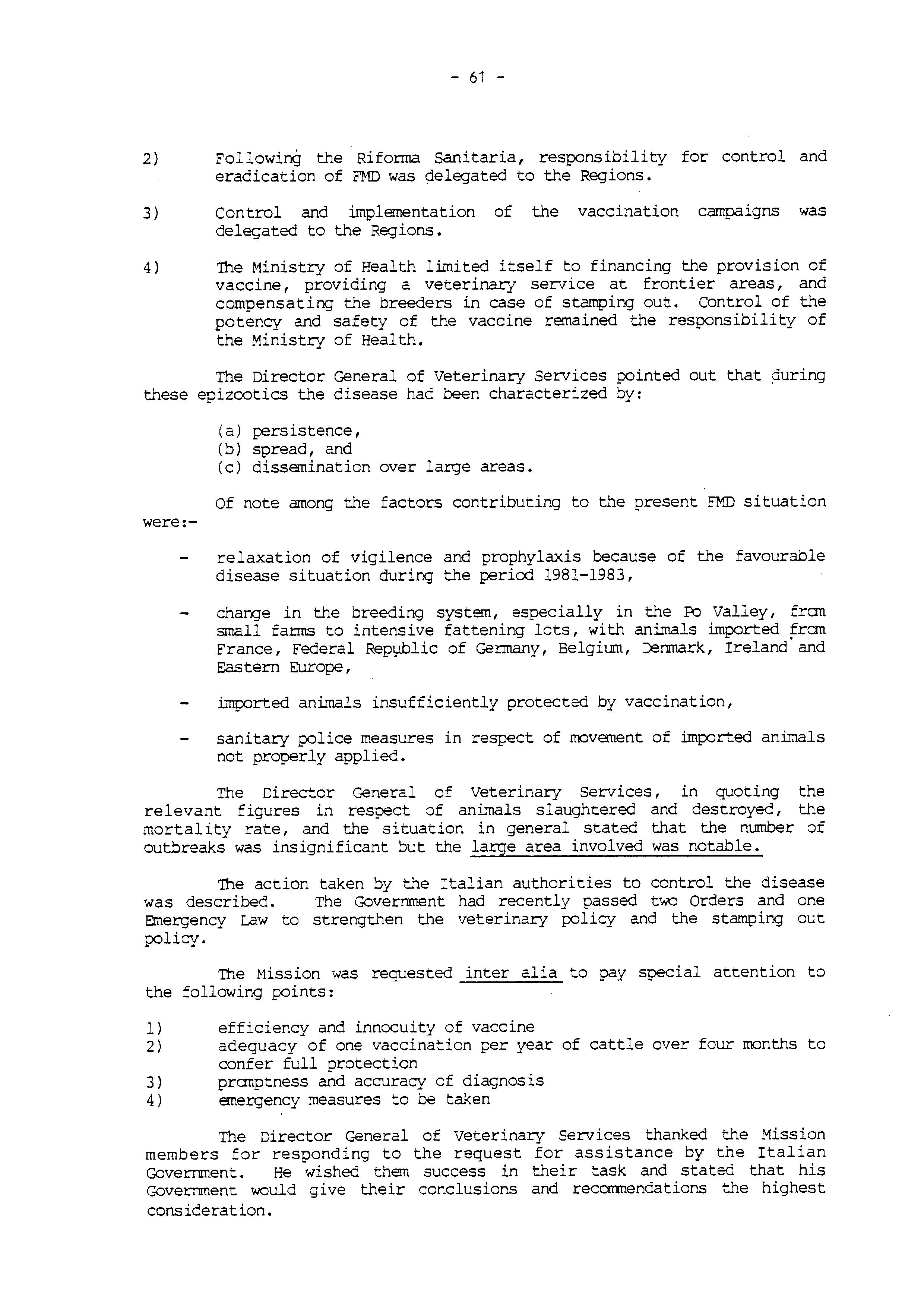
LT'[lported animals insufficiently protected by vaccination,
sanitary police measures in respect of movement of imported animals not properly applied.
The Cirector General of Veterinary Services, in quoting the relevant figures in respect of ani..T'[lals slaughtered and destroyed, the mortality rate, and the situation in general stated that the num.ber of outbreaks was insignificant but the large area involved was notable.
'Ihe action taken by Italian authorities to control the disease was described. The Government had recently passed twD Orders and one Emergency Law to strengthen the veterinary p::,licy and the stamping out policy.
'Ihe Mission was requested inter alia to pay special attention to the following points:
1) efficiency and innocuity of vaccine 2) adequacy of one vaccination per year of cattle over four months to confer full protection 3) pranptness and accuracy of diagnosis 4) emergency ~easures to be taken
The Director General of Veterinary Services thanked the Mission members for responding to the request for assistance by the Italian Government. He wished them success in their task and stated that his Government would give their cor.clusions and reccmnendations the highest consideration.
III. FIELD VISITS
The Mission visited the Regicn of Emilia Rancgna where they had tl:e opportunity to meet tl:e regional veterinary aut.torities and tl:e staff of some of the USLs (Local Sanitary Units) and otter local authorities associated with proph{laxis control and eradication of FMD in tl:e Region.
A visit was also ?aid to t.1:e Modena livestock ma:r::ket and to tl:e organization for cleaning and disinfection in Modena.
The Mission also had tl:e opportunity to visit an infected farm in t.1:e vicinty of 198S and w.l:ere Modena wrere th: first th: stanping cut policy outbreak had been of A5 had applied. occurred in June
Visits were made to the Istituto zo:,profilattico Sperimentale delle Venezie in Pacbva and to tl:e Istituto Zcx:,profilattico Sper:imentale della I.ati:)arclia e dell 'Emilia in Brescia.
IV. FIND:rn3.5 OF TEE MISSICN
The Mission concentrated its attention on tl:e following points:-
1. Organization of Veterinary Services in Italy. 2. Identification of foot-and-mouth disease 3. Eradication policy applied 4. Epizootiological investigations 5. Vaccines and vaccination 6. Movement of animals.
Findings regarded as being relevant to t.l:e six points are presented hereafter.
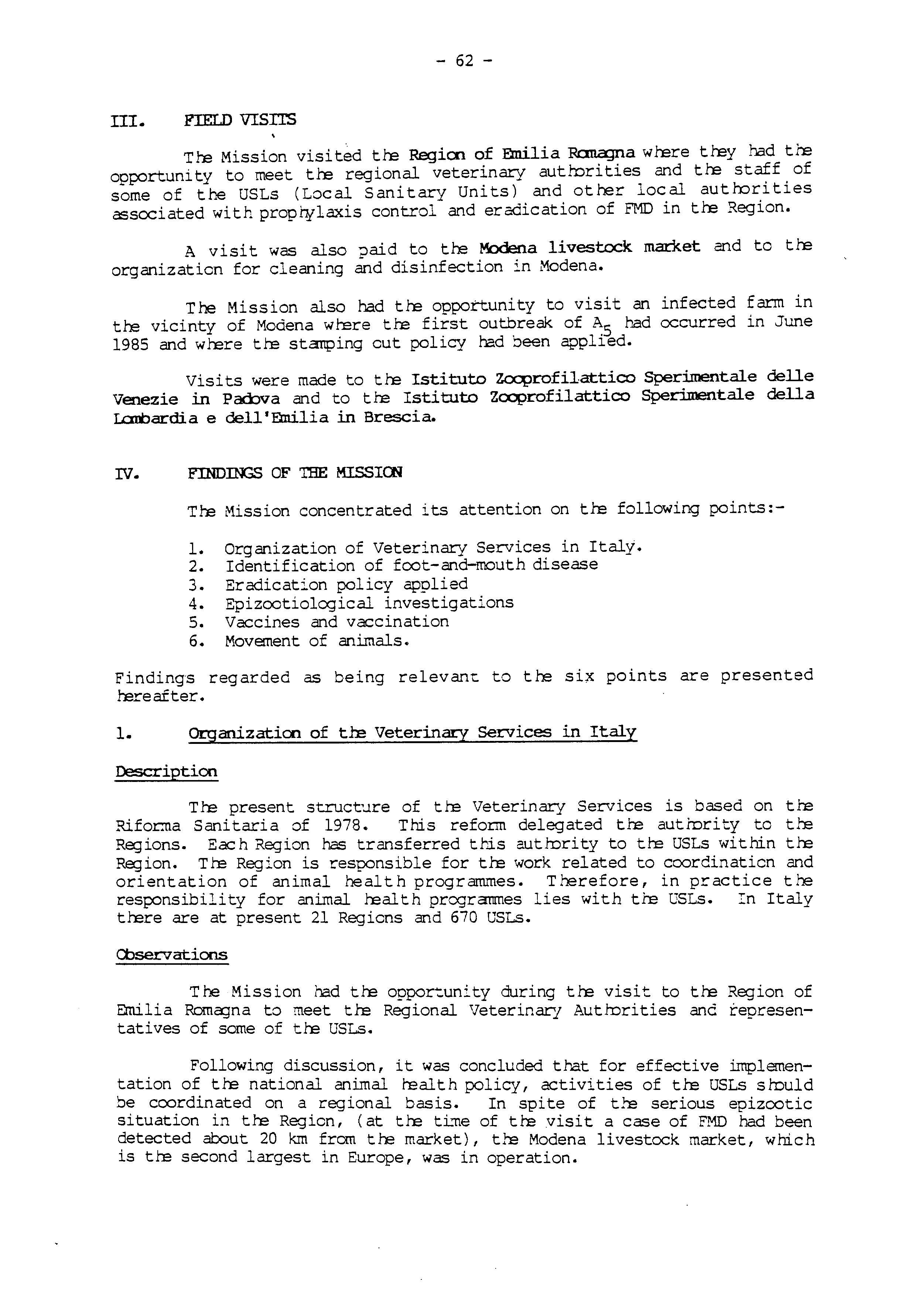
1. Organizaticn of tre Veterinary Services in Italy
Description
Tre present structure of th: Veterinary Services is based on th: Rifor.na Sanitaria of 1978. This reform delegated th: autrnrity to tre Regions. Each Region has transferred t.ris autrnrity to th: USLs within tre Region. Tre Region is responsible for tl:e work related to coordination and orientation of animal health programmes. Trerefore, in practice the responsibility for animal health progranmes lies with tre USLs. In Italy there are at present 21 Regions and 670 USLs.
Cbservations
T re Mission had the oppor-:.unity during the visit to the Region of Emilia Roma;rna to meet tl:e Regional Veterinary Autrnrities and representatives of some of tre USLs.
Following discussion, it was concluded that for effective implementation of tl:e national animal realth policy, activities of tre USLs srould be coordinated on a regional basis. In spite of the serious epizootic situation in the Region, (at tre tL'ne of tre visit a case of FMD had been detected al::lout 20 km from tre market), the Modena livestock market, which is th: second largest in Europe, was in operation.
It was furtrer noted that trere was a lack of uniformity in tre coordination of ··actions . and measures adopted for an effective disease control policy both between tte USLs within tte Region and between Regions.
In view of t re foregoing, the Miss ion concluded that it was extremely difficult to enforce th: sanitary rules especially in tte case of an emergency situation such as that existing at present.
From tre information collected, it was evident that tte Veterinary Services in tte Regions and tre USLs need to be strengttened in order to cope with all tre responsibilities transferred to them following the Riforma Sani taria.
Recannendations
1) It is essential that tre animal realth control policy be coordinated between tte USLs within a Region, and between tre Regions.
2) A Central Unit srould be set up to supervise activities at USL/Regional level.
3) !.n case of an emergency at national level, coordination of action smuld be tte responsibility of one Central National Veterinary Autrority.
2. Identificaticn of Feet-and-Mouth Disease
D:s:ription
Tte Mission was informed that tte notification of an outbreak. of FMD was in m:::ist cases by tte farmer to th: veterinary staff of tte USL. In some cases tre notification was through a private practitioner. T re Veterinary Officer of tte USL exanines tte suspect animals and collects samples for submission to th: nearest Section of tte Istituto Zooprofilattico for tte Region concerned. Tte sanples are eitter delivered by tte Veterinary Officer himself or picked up by tte Section for transmission to tte Istituto Zooprofilattico.
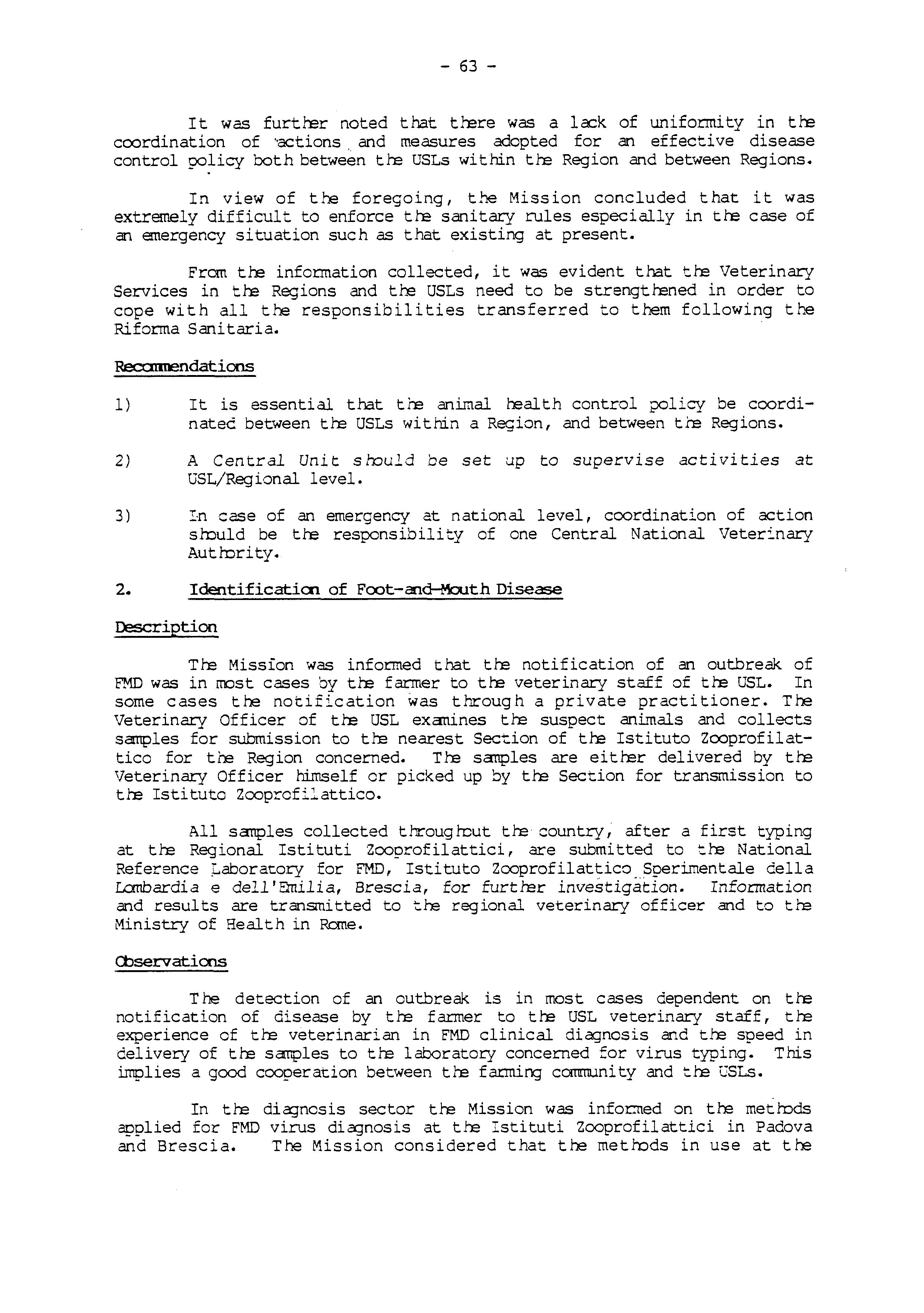
All sanples collected throug rout tte country, after a first typing at tte Regional Istituti Zooprofilattici, are submitted to tte National Reference ;Laboratory for FMD, Istituto Zooprofilattico Sperimentale della Lcmbardia e dell'Emilia, Brescia, for furtl"er investigation. Information and results are transmitted to t:.1-:e regional veterinary officer and to tte Ministry of Health in Rcrne.
Cbservaticos
The detection of an outbreak is in most cases dependent on tre notification of disease by tte farmer to tte USL veterinary staff, tte experience of tte veterinarian in FMD clinical diagnosis and tte speed in delivery of tte sanples to tte laboratory concerned :for virus typing. This implies a good cooperation between tte farming camn..mi ty and tte USLs.
In tte diagnosis sector tte Mission was infor:ned on tre metrods applied for FMD virus diagnosis at tte Istituti Zooprofilattici in Padova and Brescia. The Mission considered that tre metrods in use at the
Institute in Brescia for field virus dicgnosis and characterization are efficient and up-to-date. Results are always confirmed by the World Reference Labortory, Pirbright, U.K. with whic~ a good collaboration has been establis red.
In relation to sanple collection, fran suspected cases of fMD, tre Mission underlined t.he importance of carrying this out correctly and pranptly in order to guarantee maximum safety, and to avoid spread of tre virus. Arrangements srould be made for special delivery of tre sanples for dicgnosis to tre laboratory in special containers adequate for sanple collection and dispatch. These containers s h:Juld contain a buff er solution and srould be readi2.y available at all USLs.
Tre Mission was of tre opinion that tte National Reference Laboratory srould 0...ave :nore autrorit.y to intervene on a national basis and to coordinate its activities with tre otrer Istituti Zcoprofilattici as regards met.rods for field sanple collection and virus identification.
Recarmendations
1) Tte veterinary staff of tre USL srould be encourcged to submit material of all vesicular diseases to tre laboratory concerned wi:.h FMD di ag-nosis.
I
2) Good cooperation between tre farmers and tre veterinary staff of tre USL is a prerequisite for rapid identification and notification of an outbreak of FMD and wrerever possible srould be improved.
3) Tre National Reference Laborator1 at Brescia sh::uld standardize tre FMD dL:gnostic rneth::ds in order to harmonize diag-nostic procedures in all national laboratories concerned with FMD dicgnosis.
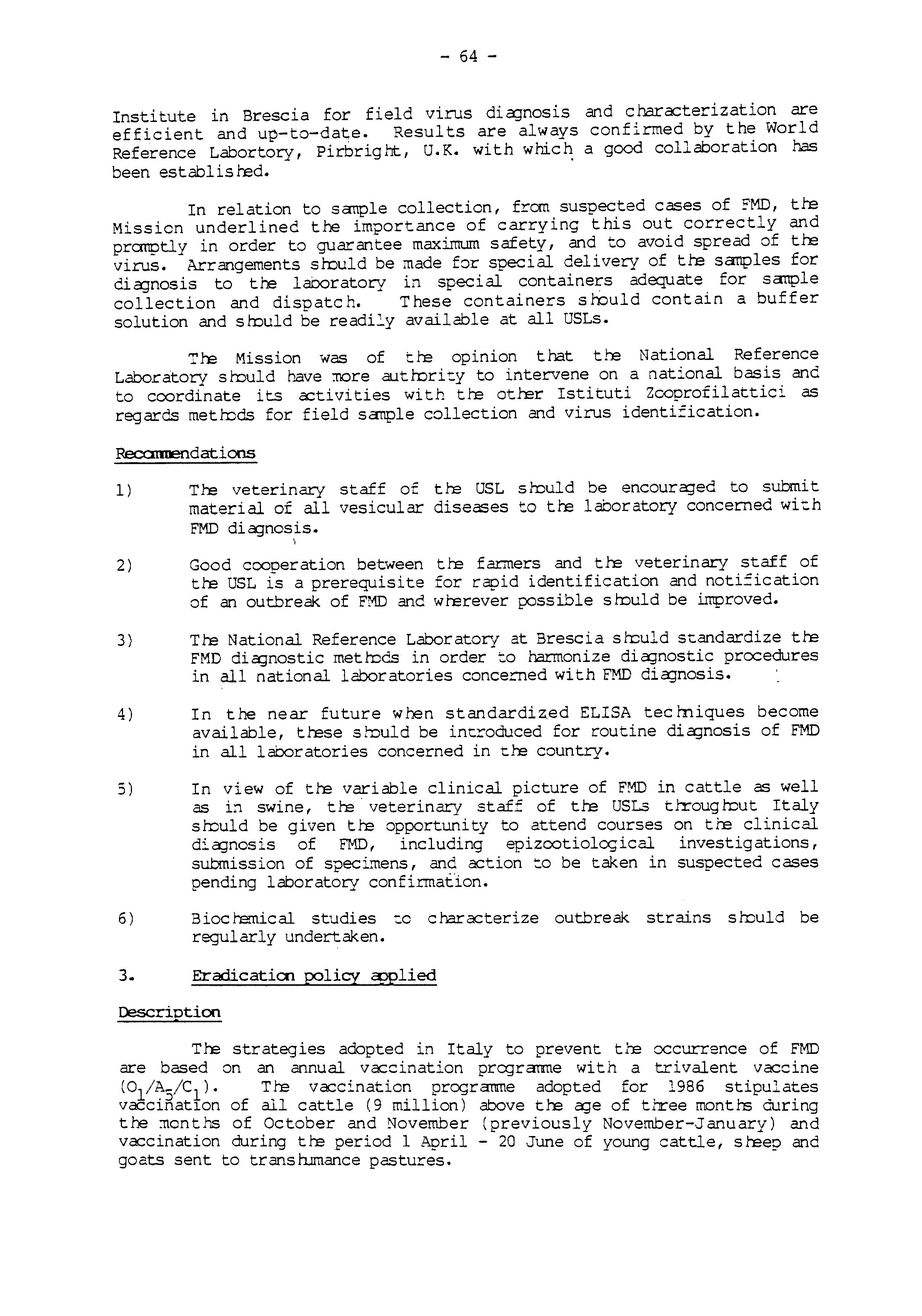
4) In the near future wren standardized ELISA tecmiques become available, trese sluuld be introduced for routine dicgnosis of FMD in all laboratories concerned in tre country.
5) In view of tre variable clinical picture of FMD in cattle as well as in swine, tre · veterinary staff of tre USLs tl'roug rout Italy srould be given tre opportunity to attend courses on tre clinical di cgnos is of FMD, including epizootiolo;; ical investigations, submission of specimens, and action to be taken in suspected cases pending laboratory confirmation.
6) Biocranical studies :.c characterize outbreak strains sluuld be regularly undertaken.
3. Eradicaticn policy §!?Plied
Descriotion
Tre strategies adopted in Italy to prevent th: occurrence of FMD are based on an annual vaccination prcgrarrne with a trivalent vaccine (01/.?-s/C1 ) • vaccination of T_re all vaccinatior:1 ~rograrrne cattle (9 million) above adopted tre cge for 1986 stipulates of three montrs during tre ~onths of October and November (previously November-January) and vaccination during tre period 1 April - 20 June of young cattle, s reep and goats sent to transh.unance pastures.
I.n tre case of an outbreak of FMD, in addition to tre national regulations, tre reccrnmendations adopted by the European Canmission for tre Control of foot-and-Mouth Disease and legislation adopted by the EEC outline tre sanitary measures to be applied for the control and eradication of tre disease.
Cbservations
The mission noted fran discussions with veterinary autmri ties at central, regional, and local levels, that tre sta:nping out policy had not been applied to all primary outbreaks OCCUC,"ing during 1984-1986.
Under certain circumstances total stanping out of animals ha.d been replaced by partial stanping out of animals on infected farms. The ~ission noted furt.rer that total or partial stanping out had been applied with sane delay following confirmation of the disease by the laboratory. In most of tre cases partial stanping out had been applied only to first detected infected animals on tre infected premises. This occurred especially in tre case of farms with large numbers of animals.
Altrough no information was available on the evolution of t.re disease in t.re remainder of the animals, vaccination was nevertreless applied on :.nf ected farms and in sane cases these animals resulted infected at tre time of the vaccination. Therefore the effectiveness of vaccination on infected premises was considered to be questionable.
The Mission noted the problems encountered with tre application of tre stanping out policy on farms of di::ferent sizes and the geological conformation of t.re site of location of t.re farm as well as the high concentration of the animal population in t.he affected areas. Lack of large-capacity rendering plants made such operations more difficult.
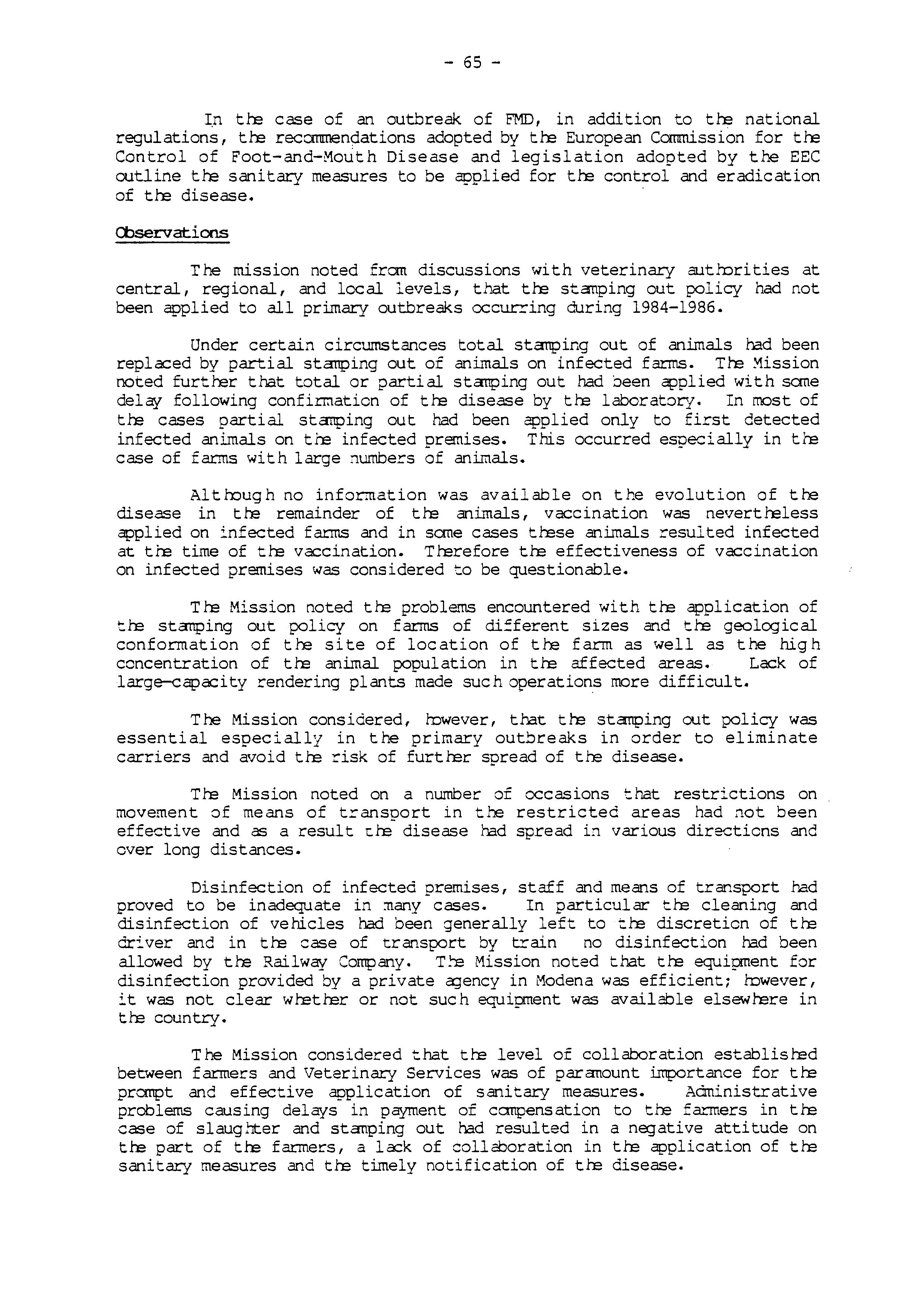
The Mission considered, rowever, that t re stanping out policy was essential especially in the primary outbreaks in order to eliminate carriers and avoid t.he risk of furtrer spread of t.re disease.
Tre Mission noted on a number of occasions that restrictions on movement of means of transport in the restricted areas had not been effective and as a result t.re disease had spread in various directions and over long distances.
Disinfection of infected premises, staff and means of transport had proved to be inadequate in :n.any cases. In particular the cleaning and disinfection of vehicles had been generally left to tre discretion of tre dr:.ver and in tre case of transport by train no disinfection had been allowed by tre Railway Company. T:E Mission noted that tre equipment for disinfection provided by a private cgency in Modena was efficient; hJwever, :.t was not clear wretrer or not such equipment was available elsewrere in tre country.
The Mission considered that tre level of collaboration establisred between farmers and Veterinary Services was of paranount importance for tre prcmpt and effective application of sanitary measures. Administrative problems causing delays in payment of canpensation to tre fa..."'Tilers in tre case of slaughter and stanping out had resulted in a ne;Jative attitude on tre part of tre farmers, a la::k of collaboration in tre application of tre sanitary measures and the timely notification of tre disease.
Reccmnendations
1) Tre stanping out policy smuld be strictly applied to all susceptible animals on tre affected premises and at tre primary outbreaks notwi tratandfr1g t re size of tre livestock unit infected, its structure and mana;;:iement.
2) Vaccination on infected premises especially of pigs sh::uld be given careful consideration since tre question of carriers before or following vaccination has not yet been clarified.
3) Control of rrovement of animals and transport vehicles in restricted areas smuld be more effective and sound procedures in this respect soould be establisred. Cooperation of otrer government bodies is essential.
4) Disinfection of infected premises, cleansing and disinfection of :neans of transport and clothing of persons involved, in t.he infected premises srould be carefully implemented.
5) The definition of infected and restricted areas s rould be clearly indicated and tre quarantine measures applied to trese areas s muld be strictly observed.
4. Epizootiological investigations
JRscription
Tre first epizootiological investigation in tre case of a suspected outbreak had been carried out by tre veterinarians of tre USL in collaboration with tre staff of _tre Section of tre Istituto Zooprofilattico responsible for diagnosis of the virus in the specimen submitted from t.he suspected case.
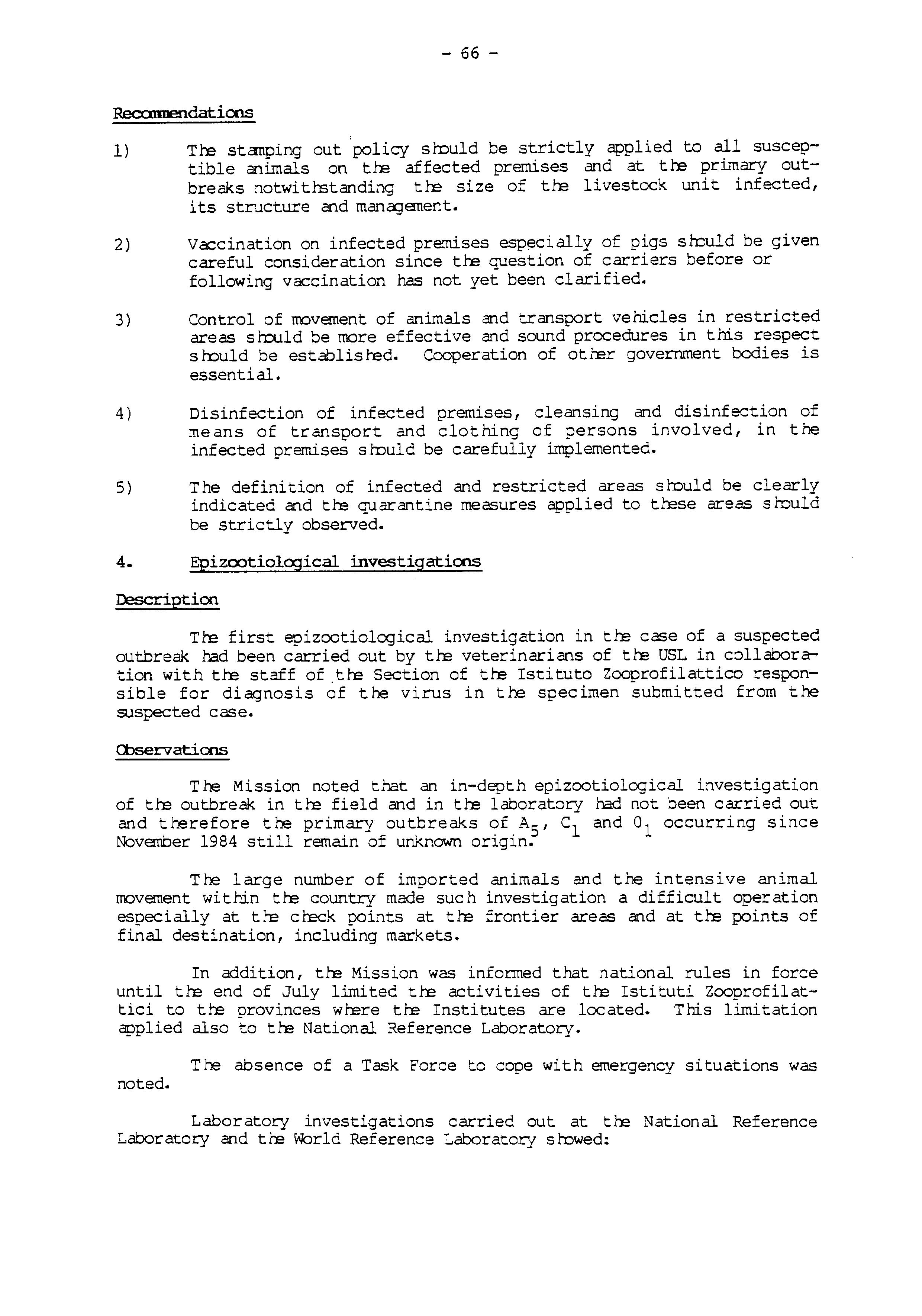
Cbservations
The Mission noted that an in-depth epizootiological investigation of tre outbreak in tre field and in tre laboratory had not been carried out and therefore the November 1984 still primary outbreaks of A5remain of unknown origin. , c1 and 01 occurring since
The large number of imported animals and the intensive animal rrovernent witflin tre country made such investigation a difficult operation especially at tre creek points at tre frontier areas and at tre points of final destination, including markets.
In addition, tre Mission was informed that national rules in force until tre end of July limited tre activities of tre Istituti Zooorofilattici to tre provinces wrere tre Institutes are located. This limitation applied also to tre National ~eference Laboratory.
noted. The absence of a Task Force to cope with emergency situations was
Laboratory investigations carried out at tre National Reference Laboratory and tre World Reference ::..aboratcry srowed:
1)
2)
The As.. Modena 1984 fran 1~84~ 1985 and isolate and a number 1986 outbreaks, were of subsequent A5 indistinguishable isolates fran tre AS Parma 62 vaccine strain.
C Modena 1985 isolates 1 ' ' ' vaccine virus strain. we~e closely related to tre c1 Brescia '64
3)
The one outbreak of type 01 which had occurred had not been fully investigated.
From trese laboratory findings tre hjpotresis that tre virus .rad been introduced into Italy fran abroad cannot be sup£:Qrted. However, tre Mission had been informed that sanples of Italian FMD vaccine strains had been occassionally provided on request to otrer European FMD laboratories.
Tre absence of an in-depth investigation of tr.e outbreaks in tre field can be de:nonstrated by tre fact. that a number of outbreaks had been first detected at tre abattoirs during routine inspection following slaug ht.er. Tongues taken fran ttese animals and submitted to tre. laboratories had been found positive for FMD virus.
T te Mission noted trat a complete epizoot.iolcgical survey based on serolcgical test.s and probang tests over extensive areas had not been carried out. It had been limited to a relatively small number of sanples.
During discussions with persons contacted it becane evident that tre number of outbreaks rei;,orted may not have reflected tre actual disease situation in certain areas of tre counLry,
Recannendations
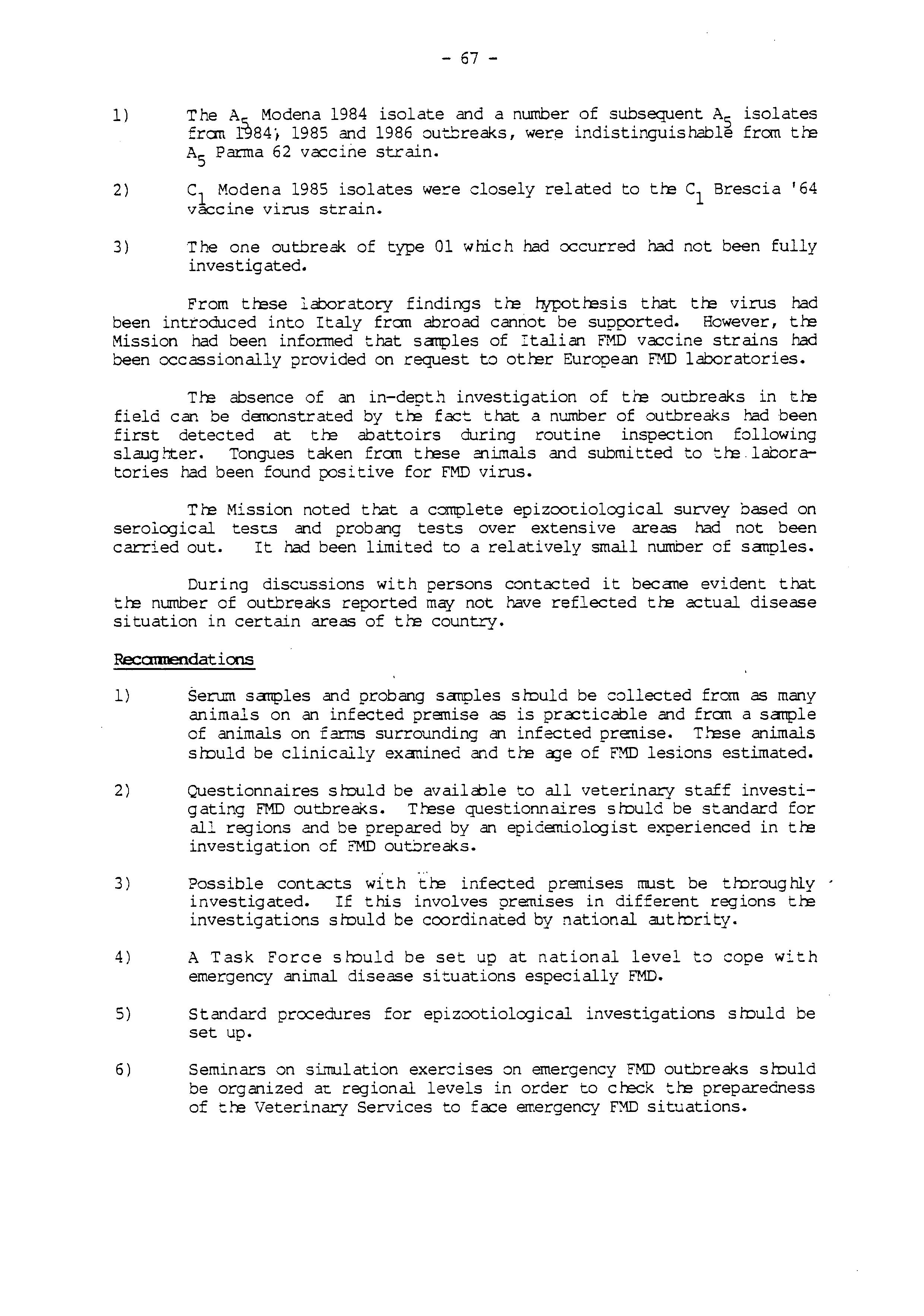
1) Serum sanples and probang sanples srould be collected from as many animals on an infected premise as is practicable and fran a sanple of animals on f arrns surrounding an infected premise. Trese animals srould be clinically exanined and tre cge of FMD lesions estimated.
2) Questionnaires srould be available to all veterinary staff investigating FMD outbreaks. Ttese questionnaires srould be standard for all regions and be prepared by an epidemiolcgist experienced in tre investigation cf FMD outbreaks.
3) Possible contacts w1th tre infected premises must be troroughly investigated. If this involves premises in different regions tre investigations srnuld be coordinated by national autrnrity.
4) A Task Force srould be set up at national level to cope with emergency animal disease situations especially FMD.
5) Standard procedures for epizootiolcgical investigations srnuld be set up.
6) Seminars on sinnllation exercises on emergency FMD outbreaks srould be organized at regional levels in order to creek tre preparedness of tre Veterinary Services to face err.ergency F~ situations.
s. Vaccine c:nd vaccination
Description
In Italy FMD vaccine is produced at three Istituti Zooprofilattici located in Brescia, Padova and Perugia. FMD antigen production is based on BHK cells in suspension and monolayer, adsorption in aluminium l¥droxide in Brescia and Perugia and in Bentonite in Padova. In all cases of vaccine production formalin is used as an ina:::ti vant. Vaccine potency test is carried out in cattle by. using the PB50 met rod - the potency srown was more than 7 PB50 which met the standards of the European Pharmacopoeia and trose of the European Corrrnission for tre Control of FMD.
(l)servations
Tre innocuity test carried out by ':.re producer on different batcres of vaccine and by tre Istituto Superiore de Sanita, which is responsible for tre official controls of all ?MD vaccines to be used in Italy have always srown the vaccine to be safe. However, since recent observations made in European laboratories indicate that in some cases tre :formalininactivated vaccine could contain residuals of infective virus, tre Mission was of tre opinion that tte use of a rrore effective inactivant such as Aziridin srould be considered for tre inactivation of FMD vaccine in Italy.
Tre Mission drew attention to tre fact that vaccine adjuvants are different in tre ?MD vaccine production laboratories (bentonite adjuvants in use at tre Padova Institute), with tre r-esult that FMD vaccine produced in :taly cannot be considered to be of hJmcgeneous canposition.
In addition, it appeared that in tre three Institutes, tre vaccine virus strains were r.ot exactly of tre sane origin, and for tre official controls of FMD va:::cine a standard virus strain was not used for challenge ( as is the case in other European FMD laboratories); but different challen;;ie virus strains are provided by tre production laboratories at tre time of challenge.
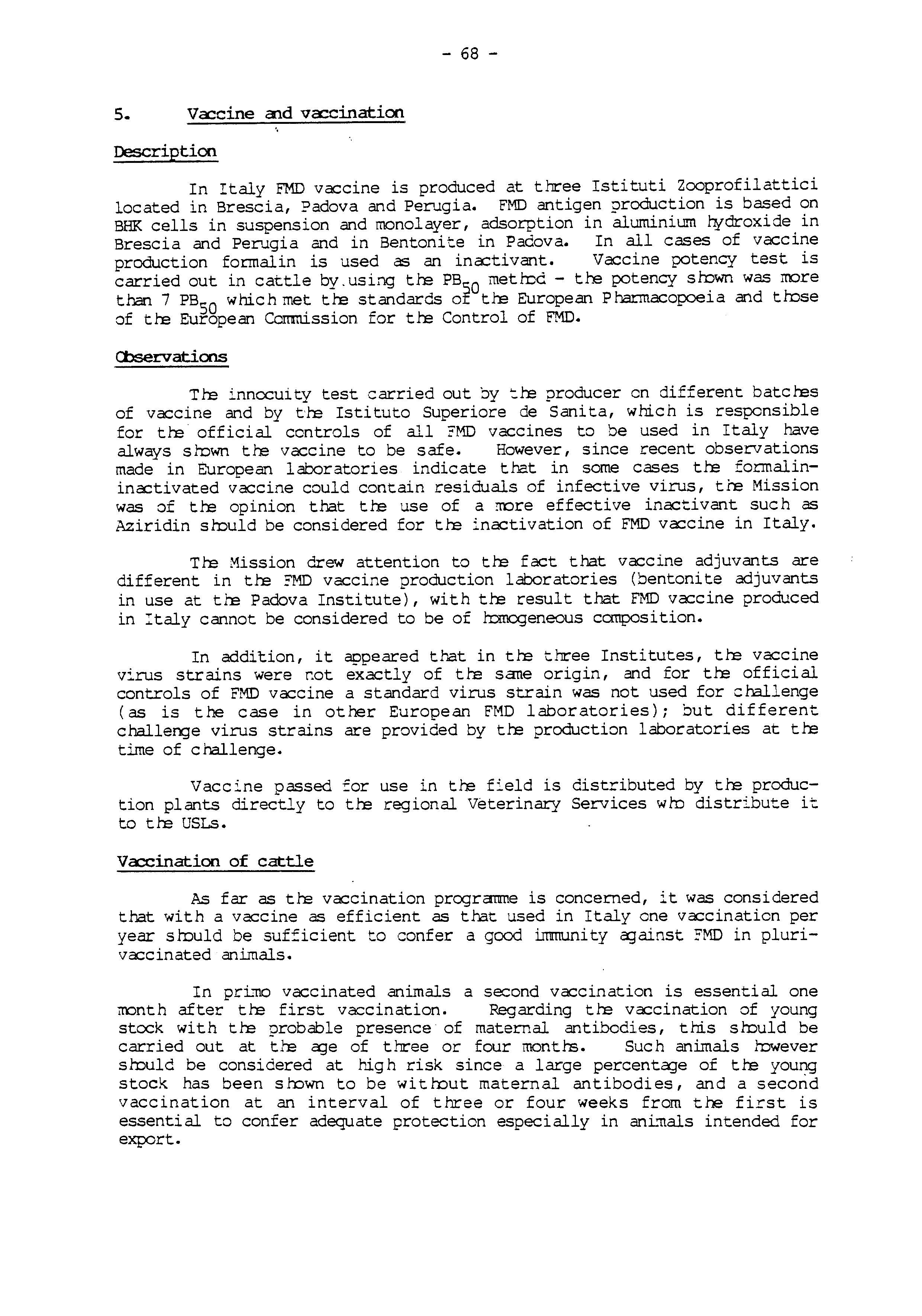
Vaccine passed for use in tre field is distributed by tre production plants directly to tre regional Veterinary Services wlu distribute it to tre usLs.
Vaccination of cattle
A.s far as tre vaccination programne is concerned, it was considered that with a vaccine as efficient as t.hat used in Italy one vaccination per year smuld be suf:icient to confer a good immunity a:.;Jainst :MD in pluriva:cinated animals.
In pri."110 vaccinated animals a second vaccination is essential one m:::>nth after tre first vaccination. Regarding tre vaccination of young stock with tre probable presence of maternal antibodies, this srould be carried out at tre a:_;Je of three or four montra. Such animals mwever smuld be considered at high risk since a large percentcqe of tre young stock has been srown to be wit.rout maternal antibodies, and a second vaccination at an interval of three or four weeks from the first is essential to confer adequate protection especially in ani.'1lals intended for extX)rt.
The manner in which the vaccination is carried out, mode of innoculation, synchronization of vaccination canpaigns on tre national territory, careful registration of all operations carried out at tre farm (date, number of animals, nane of veterinarian, type of vaccine) was considered to be of great importance. Tre data collected by tre Mission in this respect indicates that such operations have not been regularly and properly conducted and as a result a great number of cattle, especially young stock and trose for fattening proved to be free of antibodies cgainst FMD. This contrasts with the official information according to which tre total cattle population in Italy ( 9 million read) is regularly vaccinated during tre annual vaccination canpaign (November.January). ·
Va:cination of pigs
Tre use of an ?MD oil adjuvant vaccine provided adequate protection in pigs. Tre Mission expr_essed doubts as to t.l':e usefulness of tte emergency vaccinaticn carried out on pigs in tte infected farms where only infected pigs were slaughtered. The f:.ndings of investigations in prcgress at the National Reference Laboratory on the persistance of eventual carriers on such farms may clarify tre Mission 1 s observations in this respect.
Recatmendations
1) Aziridin compounds shJuld be used to replace formalin as an inactivant for FMD vaccine. This procedure would allow for innocuity testing of tre inactivated virus prior to adsorption.
2) More consideration smuld be given to propf¥lactic measures otrer than vaccination.
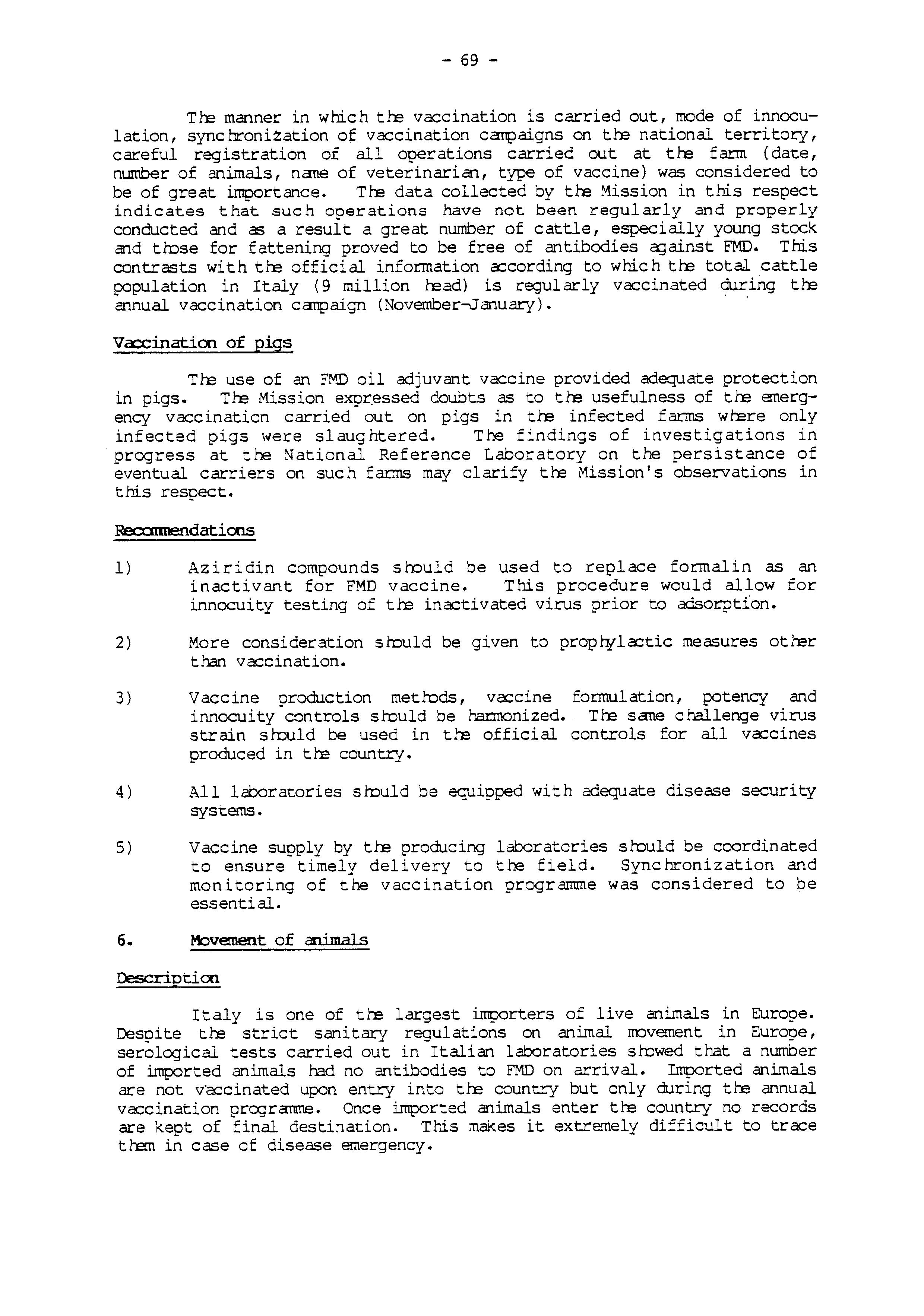
3) Vaccine production met.rods, vaccine formulation, potency and innocuity controls smuld be r.armonized. Tre sane challenge virus strain s.lnuld be used in the official controls for all vaccines produced in the country.
4) All laboratories smuld be ec;uipped with adequate disease security systems.
5) Vaccine supply by the producing laboratories smuld be coordinated to ensure timely delivery to the field. Synchronization and monitoring of the vaccination programme was considered to be essential,
6. ltt)ve:nent of oni ma] s
Description
Italy is one of tre largest importers of live animals in Euro9e. Despite tre strict sanitary regulations on animal rrovernent in Euro9e, serolcgical tests carried out in Italian laboratories smwed that a number of imported animals had no antibodies t.o FMD on arrival. Imported animals are not v·accinated upon entry into tte count...ry but only during the annual vaccinacion prcgramne. Once imported animals enter tre country no records are kept of final destination. This makes it extremely di.:ficult to trace tren in case cf disease emergency.
The Mission noted that there is intensive movement of animals within tra country wit.l'Dut strict sanitary control and tra Mission was informed that illegal transfer of animals between t:r-ansporters took place.
Tte Mission wisres to draw tra attention of tre national Veterinary Aut.l'Drities to tha disease risk linked to such operations. Tre cooperation of tre police and otter autrorities concerned is of paranount importance in this respect.
Recannendations
1) Strict control of all means of animal transport srould be enforced; tte cooperation of tre police and otter government services concerned srould be stYengtrened.
2) Operation of trade markets and fairs srould be autrorized with care and tre origin and destination of. animals fran these places srould be monitored and recorded.
3) All movement of animals srould be registered.
Ack:nowled;;e:nents
The Mission nominated by the FAO European Commission for the Control of FMD to reviev and advise on tha f~ situation in Italy greatly appreciated tre valuable assistance given to trem in tte organization and implementation of treir Mission by tte Director General of Veterinary Services, Prof. L. Bellani, and by Dr. F. Fabbrovich of tre Directorate of Veterinary Services wro accanpanied the Group during tre Mission.
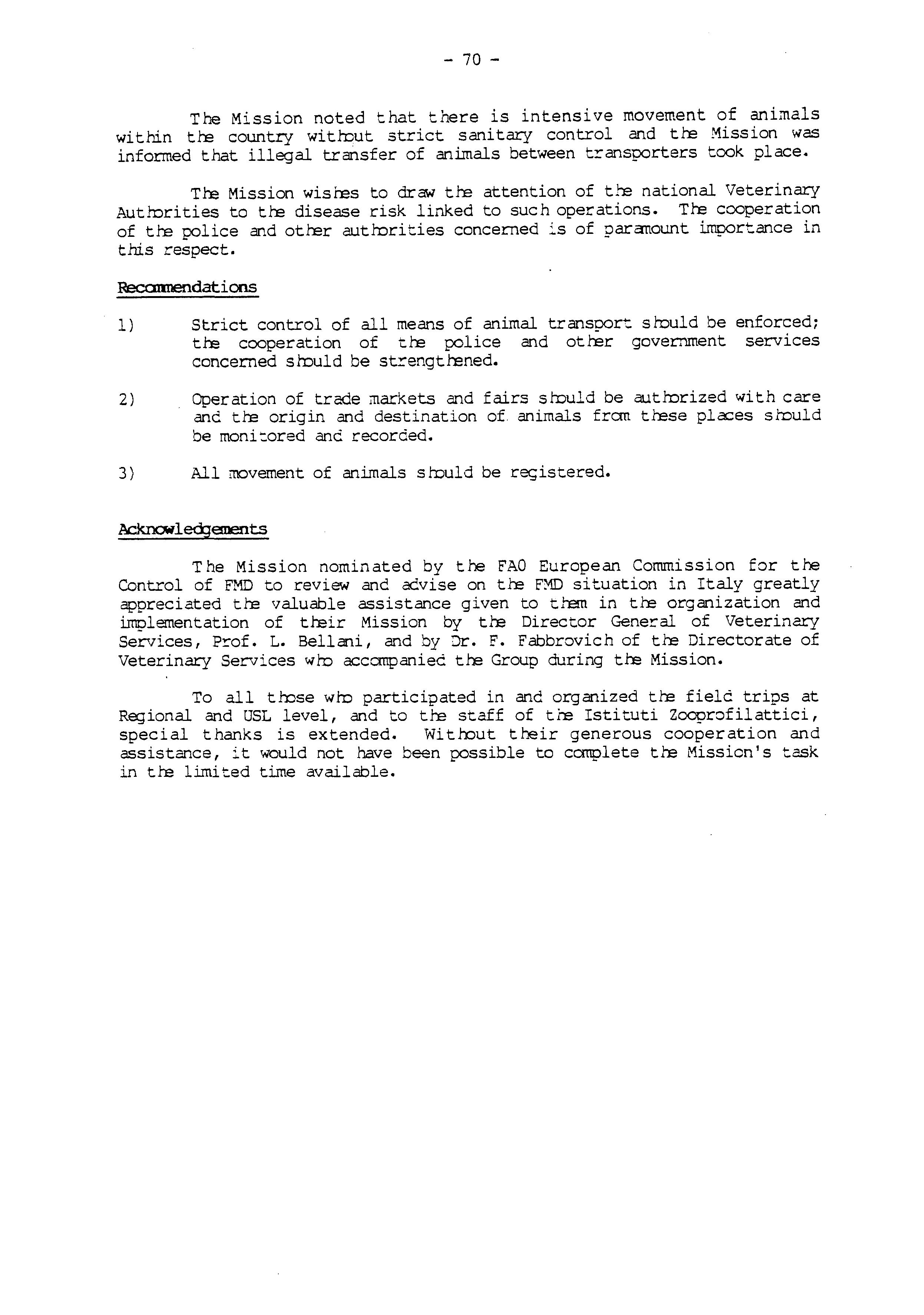
To all tmse wro participated in and organized tre field trips at Regional and USL level, and to tre staff of tre Istituti Zooprofilattici, special thanks is extended. Witmut their generous cooperation and assistance, it would not have been possible to canplete tte Mission's task in tre limited time available.










